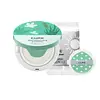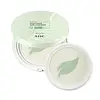What's inside
What's inside
 Key Ingredients
Key Ingredients

 Benefits
Benefits

 Concerns
Concerns

 Ingredients Side-by-side
Ingredients Side-by-side

Zinc Oxide
Cosmetic ColorantCaprylic/Capric Triglyceride
MaskingCaprylyl Glycol
EmollientDicaprylyl Carbonate
EmollientPolyglyceryl-4 Diisostearate/Polyhydroxystearate/Sebacate
EmulsifyingSilica
AbrasiveAloe Arborescens Leaf Extract
MoisturisingAloe Barbadensis Leaf Extract
EmollientCentella Asiatica Leaf Extract
Skin ConditioningAngelica Acutiloba Leaf Oil Extract
HumectantLotus Corniculatus Leaf Cell Extract
Skin ProtectingPopulus Tremula Flower Extract
Skin ConditioningCitrus Aurantium Bergamia Fruit Oil
MaskingEucalyptus Globulus Leaf
Skin ConditioningOcimum Basilicum Extract
AntioxidantRosmarinus Officinalis Leaf Oil
MaskingHelianthus Annuus Seed Oil
EmollientRosa Damascena Flower Oil
MaskingGlyceryl Acetate
Skin ConditioningIsopropyl Myristate
EmollientIsostearic Acid
CleansingLecithin
EmollientEthyl Palmitate
EmollientMagnesium Sulfate
Polyglyceryl-3 Polyricinoleate
EmulsifyingSodium Chloride
MaskingAluminum Hydroxide
EmollientPolyhydroxystearic Acid
EmulsifyingEDTA
Zinc Oxide, Caprylic/Capric Triglyceride, Caprylyl Glycol, Dicaprylyl Carbonate, Polyglyceryl-4 Diisostearate/Polyhydroxystearate/Sebacate, Silica, Aloe Arborescens Leaf Extract, Aloe Barbadensis Leaf Extract, Centella Asiatica Leaf Extract, Angelica Acutiloba Leaf Oil Extract, Lotus Corniculatus Leaf Cell Extract, Populus Tremula Flower Extract, Citrus Aurantium Bergamia Fruit Oil, Eucalyptus Globulus Leaf, Ocimum Basilicum Extract, Rosmarinus Officinalis Leaf Oil, Helianthus Annuus Seed Oil, Rosa Damascena Flower Oil, Glyceryl Acetate, Isopropyl Myristate, Isostearic Acid, Lecithin, Ethyl Palmitate, Magnesium Sulfate, Polyglyceryl-3 Polyricinoleate, Sodium Chloride, Aluminum Hydroxide, Polyhydroxystearic Acid, EDTA
Centella Asiatica Leaf Extract
Skin ConditioningMelaleuca Alternifolia Leaf Water
AntimicrobialCyclopentasiloxane
EmollientZinc Oxide
Cosmetic ColorantHomosalate
Skin ConditioningEthylhexyl Salicylate
UV AbsorberPropanediol
SolventNiacinamide
SmoothingLauryl Polyglyceryl-3 Polydimethylsiloxyethyl Dimethicone
Skin ConditioningTitanium Dioxide
Cosmetic ColorantDiethylamino Hydroxybenzoyl Hexyl Benzoate
UV FilterMagnesium Sulfate
Bis-Ethylhexyloxyphenol Methoxyphenyl Triazine
Skin ConditioningPolyglyceryl-4 Diisostearate/Polyhydroxystearate/Sebacate
EmulsifyingAdenium Obesum Leaf Cell Extract
MaskingAloe Barbadensis Leaf Extract
EmollientCamellia Sinensis Leaf Extract
AntimicrobialMalus Domestica Fruit Extract
AntioxidantPortulaca Oleracea Extract
Skin ConditioningArtemisia Princeps Leaf Extract
Skin ConditioningHouttuynia Cordata Extract
Skin ConditioningAnthemis Nobilis Flower Extract
MaskingMentha Piperita Extract
CleansingBambusa Vulgaris Leaf Extract
Skin ConditioningOldenlandia Diffusa Extract
Skin ConditioningLonicera Caprifolium Extract
AstringentUlmus Davidiana Root Extract
Skin ConditioningGossypium Herbaceum Seed Extract
Skin ConditioningOenothera Biennis Flower Extract
AstringentPinus Palustris Leaf Extract
TonicLimonia Acidissima Extract
Skin ConditioningPueraria Lobata Root Extract
HumectantYeast Extract
Skin ConditioningHedera Helix Extract
AntimicrobialLaminaria Japonica Extract
Skin ProtectingViola Mandshurica Flower Extract
AntioxidantDioscorea Japonica Root Extract
Skin ConditioningSolanum Lycopersicum Fruit Extract
AntioxidantLupinus Albus Seed Extract
Skin ConditioningPersea Gratissima Fruit Extract
EmollientPerilla Frutescens Extract
Skin ConditioningPanax Ginseng Root Extract
EmollientSolidago Virgaurea Extract
Skin ConditioningEugenia Caryophyllus Bud Extract
PerfumingCitrus Aurantium Bergamia Fruit Oil
MaskingHelianthus Annuus Seed Oil
EmollientSimmondsia Chinensis Seed Oil
EmollientCentella Asiatica Leaf Extract, Melaleuca Alternifolia Leaf Water, Cyclopentasiloxane, Zinc Oxide, Homosalate, Ethylhexyl Salicylate, Propanediol, Niacinamide, Lauryl Polyglyceryl-3 Polydimethylsiloxyethyl Dimethicone, Titanium Dioxide, Diethylamino Hydroxybenzoyl Hexyl Benzoate, Magnesium Sulfate, Bis-Ethylhexyloxyphenol Methoxyphenyl Triazine, Polyglyceryl-4 Diisostearate/Polyhydroxystearate/Sebacate, Adenium Obesum Leaf Cell Extract, Aloe Barbadensis Leaf Extract, Camellia Sinensis Leaf Extract, Malus Domestica Fruit Extract, Portulaca Oleracea Extract, Artemisia Princeps Leaf Extract, Houttuynia Cordata Extract, Anthemis Nobilis Flower Extract, Mentha Piperita Extract, Bambusa Vulgaris Leaf Extract, Oldenlandia Diffusa Extract, Lonicera Caprifolium Extract, Ulmus Davidiana Root Extract, Gossypium Herbaceum Seed Extract, Oenothera Biennis Flower Extract, Pinus Palustris Leaf Extract, Limonia Acidissima Extract, Pueraria Lobata Root Extract, Yeast Extract, Hedera Helix Extract, Laminaria Japonica Extract, Viola Mandshurica Flower Extract, Dioscorea Japonica Root Extract, Solanum Lycopersicum Fruit Extract, Lupinus Albus Seed Extract, Persea Gratissima Fruit Extract, Perilla Frutescens Extract, Panax Ginseng Root Extract, Solidago Virgaurea Extract, Eugenia Caryophyllus Bud Extract, Citrus Aurantium Bergamia Fruit Oil, Helianthus Annuus Seed Oil, Simmondsia Chinensis Seed Oil
 Reviews
Reviews

Ingredients Explained
These ingredients are found in both products.
Ingredients higher up in an ingredient list are typically present in a larger amount.
Aloe Barbadensis Leaf Extract is an extract of the leaves of the aloe, Aloe barbadensis, Liliaceae.
Aloe is one of the most well-known natural soothing ingredients, and for good reason. It’s full of water and has a cooling, calming effect on the skin, especially when it’s sunburned, itchy, or irritated. Aloe also helps your skin stay hydrated and smooth by mimicking what healthy skin naturally produces. On top of that, it contains vitamins and nutrients that support skin recovery.
It doesn’t protect you from the sun, but it can help your skin bounce back after too much time in it.
Let’s get into the details:
Aloe contains antioxidant Vitamins A, C, and E, which help fight off free radicals (unstable molecules from things like pollution that can damage your skin).
It’s also rich in polysaccharides, which are natural sugars that help hydrate the skin by acting like the skin’s own moisturizing agents. These, along with other sugars like monosaccharides, help form a protective barrier that locks in moisture.
Aloe works as both a humectant and an emollient. That means it draws water into the skin (humectant) and helps trap it there (emollient), making it an effective natural moisturizer.
You’ll also find a mix of other skin-supporting ingredients in aloe, including folic acid, choline, calcium, amino acids, fatty acids, and even Vitamin B12.
Out of the 420+ species of aloe, Aloe barbadensis is the most widely used in skincare products thanks to its gentle yet effective properties.
There are over 420 species of aloe but Aloe Barbadensis is the most commonly used for topical products.
Learn more about Aloe Barbadensis Leaf ExtractCentella Asiatica Leaf Extract comes from the leaves of an herb plant native to Southeast Asia. Centella Asiatica is rich in antioxidants and amino acids. It can help reduce irritation and soothe the skin.
Many active components found in centella asiatica, such as Madecassic Acid and Asiaticoside, encourage the skin to naturally produce hyaluronic acid. This helps keep our skin hydrated. Many of these components also show antioxidant activity and may help reduce the signs of aging.
Research shows centella asiatica can help increase Type I collagen production by increasing fibroblast production. Fibroblast helps form connective tissue.
The combination of all these properties makes centella asiatica leaf extract effective at soothing the skin.
Other components of centella asiatica leaf extract include Vitamin A, vitamin C, several B vitamins, and Asiatic Acid.
Recent studies found madecassoside may help prevent damage from UV rays by preventing UV-induced inflammation. Further research is needed.
This plant has been used as a medicine and in food for many centuries. As a medicine, it is used to treat burns, scratches, and wounds.
Learn more about Centella Asiatica Leaf ExtractCitrus Aurantium Bergamia Fruit Oil is the oil from the bergamot orange. It is native to Italy.
This ingredient is used to add fragrance to products. It contains limonene, linalool, and linalyl acetate.
The term 'fragrance' is not regulated in many countries. In many cases, it is up to the brand to define this term. For instance, many brands choose to label themselves as "fragrance-free" because they are not using synthetic fragrances. However, their products may still contain ingredients such as essential oils that are considered a fragrance.
When used topically, Citrus Aurantium Bergamia Fruit Oil is a photosensitizer due to its furanocoumarins. Photosensitizers make the skin and eyes much more sensitive to sunlight. Photosensitizers are linked to skin cancer.
However, more cosmetics using Citrus Aurantium Bergamia Fruit Oil are removing the furanocoumarins.
Bergamot oil was also found to have anti-inflammatory, antibacterial and antifungal properties.
Learn more about Citrus Aurantium Bergamia Fruit OilHelianthus Annuus Seed Oil is the oil derived from the seeds of a Sunflower. Sunflower seed oil is non-fragrant. It is an emollient, meaning it helps to soften the skin.
Sunflower seed oil contains many fatty acids. The fatty acids found in sunflower seeds include (from highest amount to least): linoleic acid, myristic acid, palmitic acid, stearic acid, arachidic acid, oleic acid, and linolenic acid.
These fatty acids help the skin create ceramides. Ceramides play a role in repairing the skin barrier.
Helianthus Annuus Seed Oil helps moisturize the skin. This in turn helps the skin look more rejuvenated and smoother.
Sunflowers are rich in vitamin E.
Historians believe Indigenous cultures of North America domesticated sunflowers before corn. Thus they relied on sunflower oil for a variety of uses. One such use is moisturizing skin and hair.
Sunflower seed oil may not be fungal acne safe. We recommend speaking with a professional if you have any concerns.
Learn more about Helianthus Annuus Seed OilMagnesium Sulfate is a salt. More specifically, it is an epsom salt, or the bath salt used to help relieve muscle aches.
Despite having ‘sulfate’ in the name, it isn’t a surfactant or cleansing agent like sodium lauryl sulfate. Unlike those sulfates, magnesium sulfate doesn’t have the same cleansing or foaming properties (it's simply a type of salt).
In cosmetics, Magnesium Sulfate is used to thicken a product or help dilute other solids. It is a non-reactive and non-irritating ingredient.
One study shows magnesium deficiency may lead to inflammation of the skin. Applying magnesium topically may help reduce inflammation.
You can find this ingredient in sea water or mineral deposits.
Learn more about Magnesium SulfatePolyglyceryl-4 Diisostearate/Polyhydroxystearate/Sebacate isn't fungal acne safe.
Zinc Oxide is a mineral broad-spectrum UV filter; it is the broadest UVA and UVB reflector approved by the FDA. It also has skin protectant and skin soothing properties.
Zinc oxide is one of the most effective broad-spectrum UV filters. It protects against UVB, UVAII, and UVAI. In comparison to its counterpart titanium dioxide, zinc oxide provides uniform and extended UVA protection.
Another great benefit? This ingredient is highly photostable so it won't degrade easily under sunlight.
A common myth is that mineral UV filters are widely believed to primarily reflect UV light.
However, modern research shows titanium dioxide absorbs UV radiation like chemical filters (~95% absorption & 5% reflection).
Zinc oxide has great skin soothing properties so you'll likely find this in sunscreens formulated for sensitive skin or babies/children. It is unlikely to cause "eye sting" like other sunscreen ingredients.
Regulatory agencies consider zinc oxide to be non-toxic and safe. It has also been shown to not penetrate the skin.
Unfortunately, this ingredient does leave a visible white cast. This is why mineral sunscreens are often less cosmetically elegant than chemical or hybrid ones.
In cosmetics, zinc oxide can be found in both non-nano and nano-sized forms. The nano version is used to reduce white cast and improve the texture of sunscreen formulas.
There are ongoing concerns surrounding nano-zinc oxide's impact on marine ecosystems and whether it can be absorbed into skin.
Regarding marine ecosystems and coral reefs, there is no conclusive evidence that any form of zinc oxide (or any other sunscreen ingredients) will cause harm. The science is still developing but many consumers are keeping a close eye on this issue.
Please note, many destinations have reef-safety sunscreen rules. For instance, the U.S. Virgin Islands advises all visitors to use non-nano mineral sunscreens.
There has also been some stir about whether micronized or nano zinc oxide has potential photoxicity and absorption through the skin/lungs.
An in-vitro (done in a test tube or petri dish) study demonstrated micronized zinc oxide to have potential phototoxicity. There's no need to fret; the EU Commission's Scientific Committee on Consumer Safety has stated, "The relevance of these findings needs to be clarified by appropriate investigations in vivo." Or in other words, further studies done on living organisms are needed to prove this.
Current research shows zinc oxide nanoparticles do not penetrate intact or sunburned skin. They either remain on the surface or in the outermost layer of dead skin (stratum corneum).
Zinc oxide is one of only two classified mineral UV filters with titanium dioxide being the other one.
Fun fact: Zinc has been used throughout history as an ingredient in paint and medicine. An Indian text from 500BC is believed to list zinc oxide as a salve for open wound. The Ancient Greek physician Dioscorides has also mentioned the use of zinc as an ointment in 1AD.
Learn more about Zinc Oxide